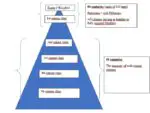Ancient Greece is known for many things. Amazing architecture, genius philosophers and inventors, the Greco-Persian War, the Spartan army, and the Athenian navy. But one type of question about Ancient Greece usually stays unanswered. How much did people in ancient Greece make? And how expensive were daily goods in ancient Greece? Both questions will be answered in the following!
In the 5th century BC, the oarsmen in the Athenian navy, as well as the Hoplites, made 1 drachma per day. Skilled laborers made 2 drachmas per day while an unskilled laborer made ½ half of a drachma (3 obols) per day. 1 loaf of bread did cost 1 Obol while a lamb, as well as a new pair of shoes, did cost 8 drachmas. A normal house in Athens did cost 1000 drachmas.
Let`s take a closer look!
However, when we look at prices and wages we always have to consider that the numbers changed over time. So in the following, I would like to present the prices of daily goods in the city of Athens and the wages an Athenian could expect in the 5th century BC, the time of the Persian Wars and the Peloponnesian War, depending on his qualifications.
Prices in Ancient Greece in Athens in the 5th century BC
| 1 loaf of bread | 1 obol |
| The standard rate for a prostitute | 3 obols |
| 1 gallon of olive oil | 5 drachmas |
| 1 lamb | 8 drachmas |
| 1 pair of normal shoes | 8 drachmas |
| 1 average slave | 175 drachmas |
| 1 average house | 1000 drachmas |
Wages in Ancient Greece in Athens in the 5th century BC
| Daily pay of an unskilled worker | 3 obols |
| Daily pay of an oarsman in the Athenian navy | 1 drachma |
| Daily pay of a Hoplite | 1 drachma |
| Daily pay of a skilled worker | 2 drachmas |
| Daily pay of a sculptor | Up to 6 drachmas |
| Daily pay of a doctor | Up to 6 drachmas |
Now you might be surprised to see that a Hoplite (who had to buy his own armor and weapons) received just as much money as an Athenian citizen who served as an oarsman in the Athenian navy. It is important to remember that military service in Ancient Greece was seen as the duty of every citizen. So the 1 drachma that both Athenian Hoplites and oarsmen received was not so much a pay for their military service but a contribution to the costs of being on military duty!
Now you might have seen that I did not include the price of slaves in this article. The reason for that is not that there wasn`t any slavery in Ancient Greece – there was. I did not include the price of slaves in ancient Greece since I wrote an entire separate article on that topic. Please feel free to check it out!
Ok, so now we`ve talked a lot about obols and drachmas. But what was the relation between the value of these coins?
The Coinage of Athens
| 6 obols | 1 drachma |
| 100 drachma | 1 mina |
| 60 minae | 1 Athenian talent (56,88 lbs of silver) |
The Athenian talent becomes especially important when we talk about ancient Greek state finances (Alexander the Great only had 50 talents in his treasury but a debt of 500 talents when he marched into the Persian Empire)
And the Delian League guaranteed its leader Athens an annual income of 400 talents. But the Delian League is a story for another time.
I hope you enjoyed this article.
Do you want to learn more about ancient Greece? Then you might want to check out my article here where I talk about why the Greeks chose to fight at the passage of Thermopylae in 480 BC and what the Greek plan was in the Battle of Thermopylae.
Take care of yourself because you deserve it. You really do.
Until next time
Yours truly
Luke Reitzer
Sources
Leonhard Schumacher: Sklaverei in der Antike: Alltag und Schicksal der Unfreien.*
Hans Volkmann: Die Massenversklavungen der Einwohner eroberter Städte in der hellenistisch-römischen Zeit.
Disclaimer: This post contains affiliate links that are identifiable by the *. If you use these links to buy something we may earn a small commission without additional cost for you. Thanks.

